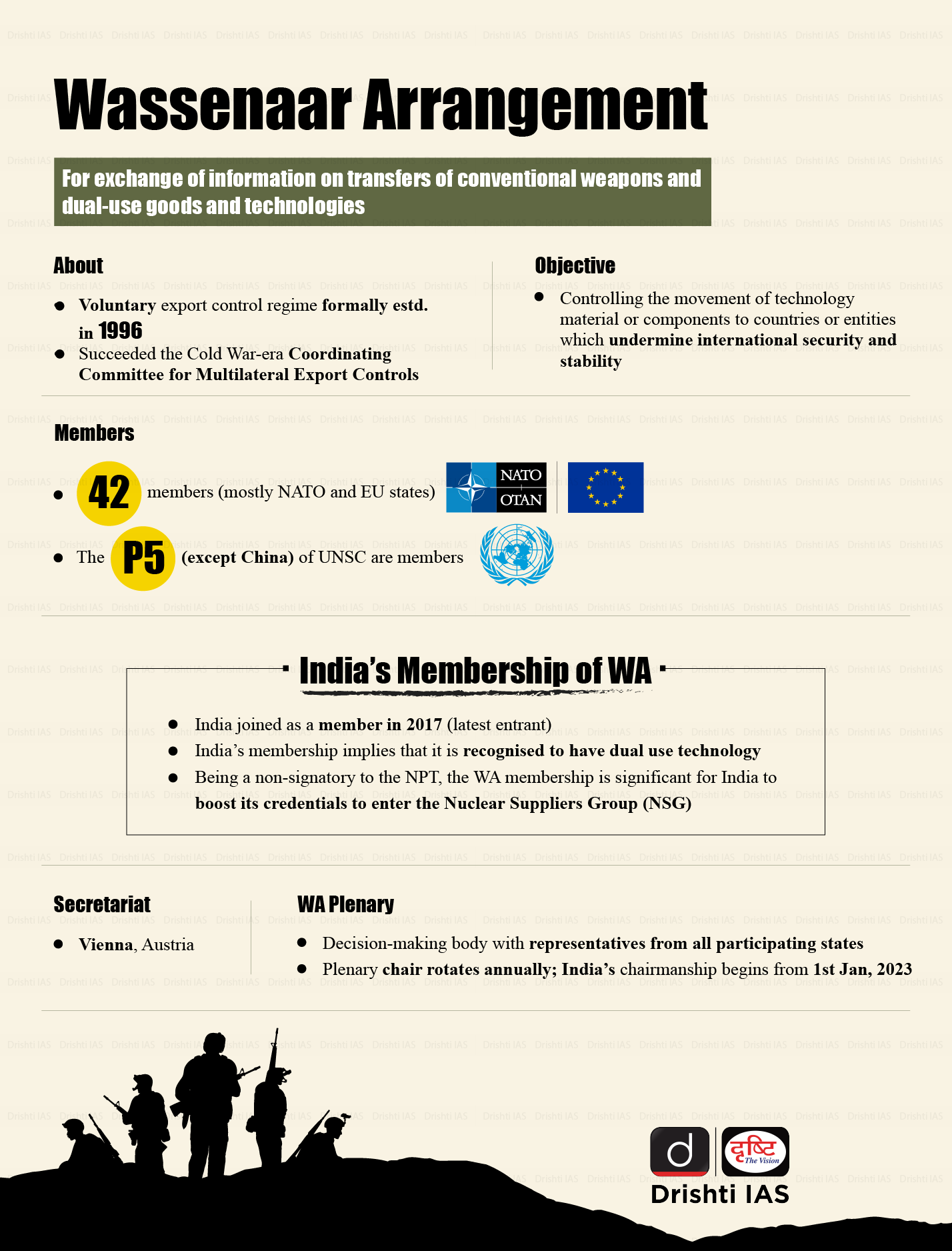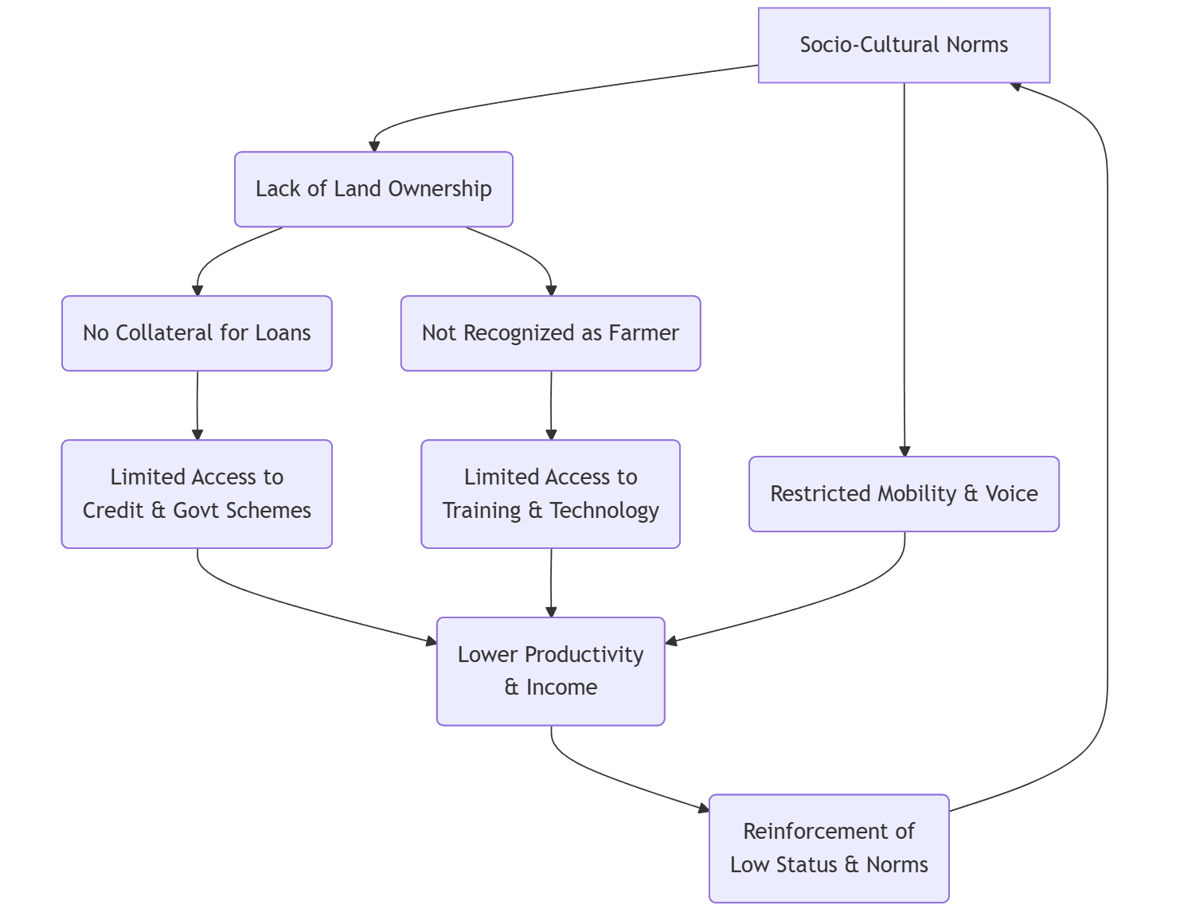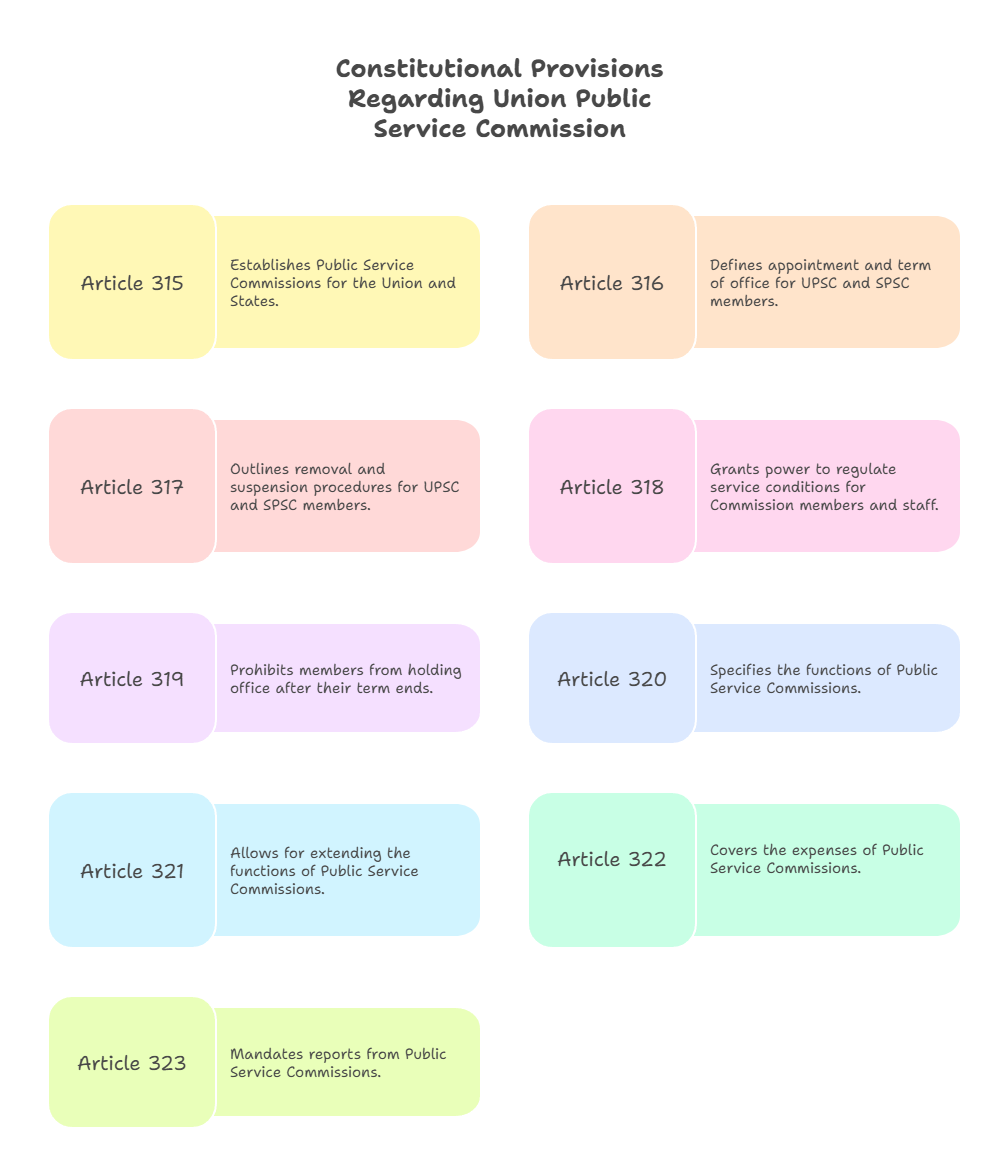International Relations
Wassenaar Arrangement
For Prelims: Wassenaar Arrangement, No Money for Terrorism, Nuclear Suppliers Group, Non-Proliferation Treaty
For Mains: Wassenaar Arrangement, Multilateral Export Control Regimes and Global Security, Challenges of Regulating Digital Technologies and Cloud Services
Why in News?
Protests erupted against Microsoft after allegations that its Azure cloud services were used to support Israeli military operations in Palestine, causing civilian harm and raising concerns over loopholes in the Wassenaar Arrangement’s export control framework.
What is Wassenaar Arrangement?
- About: The Wassenaar Arrangement is the first multilateral body focused on export controls for conventional arms and dual-use (civilian and potential military applications) technologies.
- Established in 1996 in Wassenaar, Netherlands, it succeeded the Cold War–era Coordinating Committee for Multilateral Export Controls (CoCom) and functions as a forum where all decisions are taken by consensus.
- Objective: The Arrangement aims to enhance regional and international security by promoting transparency and responsibility among participating states and coordinating policies to prevent sensitive technologies from reaching countries that could threaten security.
- Structure and Governance:
- Plenary: It is the main decision-making body. The Chair rotates yearly, India chaired the plenary of the Wassenaar Arrangement in 2023.
- Secretariat: Based in Vienna, Austria, supports all Arrangement functions.
- Members: 42 countries, India joined in 2017.
- Working Procedure: Its control framework includes the Munitions List, covering items like tanks, combat aircraft, and small arms.
- Dual-Use List, which includes technologies with both civilian and potential military applications.
- Participating states agree on control lists and share information, while each government retains full discretion over licensing, implementation, and enforcement of the rules.
- Scope: Originally, the Arrangement focused on physical exports (devices, chips, hardware). In 2013, the Arrangement expanded to include “intrusion software”, i.e., software that bypasses network security or enables cyber-surveillance.
India and Wassenaar Arrangement
- Wassenaar Arrangement strengthens India’s role in non-proliferation and arms control, it aligns India’s Special Chemicals, Organisms, Materials, Equipment and Technologies (SCOMET) export controls with global norms.
- It facilitates access to sensitive dual-use technologies for space, defence, and digital sectors, and supports its counter-terrorism diplomacy, including initiatives like No Money for Terrorism (NMFT).
- Wassenaar Arrangement strengthens India’s credentials for entry into the Nuclear Suppliers Group, where China has blocked India’s membership.
- It reinforces India’s commitment to global non-proliferation norms despite being a non-signatory to the Nuclear Non-Proliferation Treaty (NPT).
What are the Challenges facing the Wassenaar Arrangement?
- Outdated Focus on Physical Exports: Originally designed to control hardware, chips, and devices, not cloud services or digital technologies.
- Modern software, Software as a Service (SaaS), and Artificial Intelligence (AI) tools fall into grey areas not explicitly regulated under the arrangement.
- Current control lists do not cover mass surveillance, profiling, cross-border data systems, or human rights abuses. Technologies that can be misused for repression are often outside the scope of the Arrangement.
- Ambiguity Around Cloud and Remote Access: Traditional rules of Wassenaar Arrangement do not treat remote access, Application Programming Interface (API) calls, or administrative rights as exports.
- This allows companies or states to bypass control regimes while enabling potentially risky technology transfers.
- Voluntary Nature and Lack of Enforcement: The Arrangement is based on consensus; any member can block changes. Domestic implementation varies by country, leading to patchy coverage and inconsistent enforcement.
- Cloud services, AI, and cyber tools evolve faster than the consensus-based decision-making process. There is no mechanism to fast-track urgent updates or sunset outdated controls, making the regime less relevant.
- Divergent National Interpretations: Under the Wassenaar Arrangement each country interprets and implements the rules differently, creating loopholes for defensive research or internal transfers.
- No standardized system exists to coordinate cross-border licensing or track high-risk users.
- Limited Human Rights Consideration: Licensing decisions under Wassenaar Arrangement often focus on military use or weapon of mass destruction (WMD) proliferation rather than the risk of civilian harm, surveillance abuse, or discrimination.
What Measures can Strengthen the Wassenaar Arrangement?
- Expand the Scope of Controlled Technologies: Include cloud infrastructure, AI systems, digital surveillance tools, biometric systems, and cross-border data transfers. Clearly define benign versus malicious uses to avoid over-regulating legitimate applications.
- Learn from the EU dual-use regulations that treat cloud transmissions as potentially controlled technologies.
- Redefine “Export” for the Digital Era: Treat remote access, API calls, software-as-a-service invocation, and administrative rights as equivalent to physical exports.
- Ensure that virtual or cloud-based transfers fall under control regulations to close loopholes.
- Introduce Binding Rules and Minimum Standards: Move beyond voluntary commitments to mandatory licensing standards. Implement peer review mechanisms to ensure compliance across member states.
- Establish shared watchlists of high-risk users or entities. Enable real-time red alerts and technical interoperability standards among licensing authorities. Align national licensing policies to mitigate cross-border risks effectively.
- Make Governance Agile and Responsive: Create a specialized technical committee or secretariat to fast-track interim updates. Host domain-specific regimes for AI, cyber weapons, and digital surveillance technologies that can evolve faster than the general Arrangement.
- Integrate Human Rights and Risk Assessment: Consider user identity, jurisdiction, oversight, legal mandate, and misuse potential in licensing decisions.
- Ensure technology control is not only about military use or WMDs but also prevents mass human rights abuses.
Conclusion
The Wassenaar Arrangement, while foundational for global export controls, struggles to keep pace with rapidly evolving cloud and digital technologies. Strengthening the regime with binding rules, agile oversight, and end-use controls is essential to prevent misuse and safeguard human rights.
|
Drishti Mains Question: Q. Evaluate the role of the Wassenaar Arrangement in promoting global security and non-proliferation. How has its relevance evolved in the digital and cloud era? |
Frequently Asked Questions (FAQs)
1. What is the Wassenaar Arrangement?
Ans: A 1996 multilateral regime controlling conventional arms and dual-use technologies to enhance global security.
2. Which lists are maintained under the Wassenaar Arrangement?
Ans: Munitions List (tanks, aircraft, small arms) and Dual-Use List (civilian/military tech).
3. Why is the Wassenaar Arrangement’s relevance challenged today?
Ans: It struggles with cloud, AI, and digital surveillance technologies, has a voluntary consensus-based framework, inconsistent national implementation, and limited human rights considerations.
4. What reforms can strengthen the Wassenaar Arrangement?
Ans: Expand scope to digital/cloud tech, redefine “export,” introduce binding rules, enforce real-time watchlists, integrate human rights and risk-based licensing.
UPSC Civil Services Examination, Previous Year Questions (PYQs)
Prelims
Q. Recently the USA decided to support India’s membership in multi-lateral export control regimes called the “Australia Group” and the “Wassenaar Arrangements”. What is the difference between them ? (2011)
1. The Australia Group is an informal arrangement which aims to allow exporting countries to minimize the risk of assisting chemical and biological weapons proliferation, whereas the Wassenaar Arrangement is a formal group under the OECD holding identical objectives.
2. The Australia Group comprises predominantly Asian, African and Page 9 North American countries, whereas the member countries of Wassenaar Arrangement are predominantly from the European Union and American continents.
Which of the statements given above is/ correct?
(a) 1 only
(b) 2 only
(c) Both 1 and 2
(d) Neither 1 nor 2
Ans: (d)
Q. In India, why are some nuclear reactors kept under “IAEA safeguards” while others are not? (2020)
(a) Some use uranium and others use thorium
(b) Some use imported uranium and others use domestic supplies
(c) Some are operated by foreign enterprises and others are operated by domestic enterprises
(d) Some are State-owned and others are privately owned
Ans: (b)
Mains
Q. With growing energy needs should India keep on expanding its nuclear energy programme? Discuss the facts and fears associated with nuclear energy. (2018)


Social Justice
Empowering Women in Agriculture
For Prelims: Periodic Labour Force Survey (PLFS), Mahila Kisan Sashaktikaran Pariyojana, Kisan Credit Cards, Tea, Coffee, Gram Panchayats, Cooperatives, Farmer Producer Organizations, BHASHINI, Digital Sakhi, e-NAM.
For Mains: Status of Feminisation of Indian Agriculture, Challenges in Women's Agricultural Empowerment, Systemic Barriers to Women's Progress, Government Initiatives for Women Farmers, Strategies for Future Empowerment.
Why in News?
As per the Periodic Labour Force Survey (PLFS) 2023-24, women’s participation in agriculture has increased significantly, however, nearly half of them continue to remain unpaid, reflecting deep-rooted gender disparities in farm employment.
What is the Status of Women in Agriculture Across India?
- Feminisation of Agriculture: Women now make up over 42% of India’s agricultural workforce, a 135% increase in the past decade. Two out of three rural women work in agriculture.
- Prevalence of Unpaid Work: Nearly half of women in agriculture are unpaid family workers, rising from 23.6 million to 59.1 million over eight years (2017-18 to 2024-25).
- Regional Concentration: In states like Bihar and Uttar Pradesh, more than 80% of women workers are in agriculture, however, over half remain unpaid.
- Government Support: Mahila Kisan Sashaktikaran Pariyojana, Kisan Credit Cards, and Self-Help Groups collectively empower women farmers through skill development, access to formal credit, sustainable agriculture, and strengthened collective bargaining.
What Factors are Leading to Feminisation of Agriculture in India?
- Male Out-Migration: Men are migrating to cities or shifting to more lucrative rural jobs (construction, services, transport, government), leaving women to manage and work on family farms.
- Growth of the Contract Farming: Sectors like floriculture, horticulture, and tea/coffee plantations prefer women for labor-intensive tasks, viewing them as reliable, skilled, and willing to accept lower wages.
- Patriarchal Norms: Society expects women to handle home and light farm work, treating their farm labor as part of household duties or assisting men.
- Limited Alternative Opportunities: Lower literacy, restricted mobility, and social norms limit women's non-farm employment, making agriculture one of the few acceptable and accessible livelihoods in rural areas.
What are the Systemic Barriers Limiting Women’s Progress in Agriculture?
Mnemonic: WOMEN
- W - Wage Discrimination: Women in India earn 20-30% less than men, highlighting gender wage gaps and economic inequality, which limit economic empowerment.
- O - Omission from Decision-Making: Agricultural extension officers are predominantly male, excluding women from knowledge on seeds, pesticides, and sustainable practices, while their opinions are often overlooked in Gram Panchayats and farmer cooperatives.
- M - Machinery and Tool Mismatch: Farm machinery such as tractors, harvesters, and threshers is designed for male physiques, while women often lack the strength, training, or financial means to operate or access it.
- E - Entrenched Domestic Double Burden: Restricted mobility and time poverty from domestic chores, and childcare limit women’s access to markets, skill development, and community participation.
- N - Negation of Land and Identity Rights: Women own only 13-14% of land holdings, and without land titles, they are seen as cultivators rather than farmers, limiting access to credit, government schemes, and independent decision-making.
What Measures can Effectively Ensure the Empowerment of Women Farmers in India?
Mnemonic: GROW
- G - Guarantee Market Access: Free Trade Agreement (FTAs) like the one with the UK, expected to raise agricultural exports by 20%, should focus on women-intensive sectors such as tea, spices, and dairy, and support women in exporting premium products like organic foods and GI-tagged goods, using their traditional knowledge.
- R - Resource Rights and Reforms: Promote joint or individual land ownership for women to enhance access to credit, insurance, and government support, and systematically scale proven women-led Farmer Producer Organizations (FPOs) and SHGs to achieve economies of scale.
- O - Open Digital Gateways: Scale up digital platforms like e-NAM, promote voice-first AI like BHASHINI, Jugalbandi, and Digital Sakhi for digital and financial literacy.
- W - Well-being and Social Support: Provide creche facilities near farms, water supply, and clean energy to reduce women’s time poverty, while using media campaigns and awards to brand women farmers as role models.
Conclusion
To harness the potential of feminising agriculture, India must transition from recognizing women's labor to empowering them as economic agents. This requires dismantling systemic barriers like land rights denial and wage gaps, while actively promoting their access to technology, markets, and decision-making roles for inclusive growth.
|
Drishti Mains Question: Q. "The feminisation of agriculture in India has reinforced existing inequities rather than empowering women." Critically examine this statement and suggest measures for a gender-inclusive agricultural growth model. |
Frequently Asked Questions (FAQs)
1. What is Feminisation of Agriculture?
Ans: The feminisation of agriculture refers to the increasing participation of women in agricultural labor due to the migration of men to non-farm jobs.
2. What is the current share of women in India’s agricultural workforce?
Ans: Women now constitute over 42% of India’s agricultural workforce, marking a 135% increase in the past decade.
3. Which factors are driving the feminisation of agriculture in India?
Ans: Male out-migration, growth of contract farming, patriarchal norms, and limited non-farm opportunities for women are key drivers.
UPSC Civil Services Examination, Previous Year Questions (PYQs)
Prelims:
Q. With reference to the circumstances in Indian agriculture, the concept of “Conservation Agriculture” assumes significance. Which of the following fall under the Conservation Agriculture? (2018)
- Avoiding the monoculture practices
- Adopting minimum tillage.
- Avoiding the cultivation of plantation crops
- Using crop residues to cover soil surface
- Adopting spatial and temporal crop sequencing/crop rotations
Select the correct answer using the code given below:
(a) 1, 3 and 4
(b) 2, 3, 4 and 5
(c) 2, 4 and 5
(d) 1, 2, 3 and 5
Ans: (c)
Mains:
Q. Discuss the various economic and socio-cultural forces that are driving increasing feminization of agriculture in India. (2014)


Facts for UPSC Mains
India-EFTA Free Trade Agreement
Why in News?
India’s Free Trade Agreement (FTA) with the EFTA bloc - comprising Switzerland, Norway, Iceland, and Liechtenstein, has come into effect, marking a significant step in strengthening trade and investment ties. The agreement reflects India’s growing role in global value chains and its strategy to expand market access while attracting foreign investment.
What is India-EFTA FTA?
- About: The India-EFTA FTA (Trade and Economic Partnership Agreement (TEPA) was finalized in March 2024, and came into effect on 1st October 2025.
- It strengthens India’s global trade ties, complementing recent FTAs with UAE, Australia, and the UK.
- Objectives:
- Enhanced Market Access: EFTA has given 100% market access for India’s industrial and non-agricultural products. Tariff concessions provided on processed agricultural products.
- Investment & Jobs: EFTA nations will bring in a binding investment commitment of USD 100 billion over 15 years. This investment is expected to generate 1 million direct jobs in India.
- Dedicated Institutional Mechanism for Trade Facilitation: A dedicated EFTA Desk, operational since February 2025, acts as a single-window investment facilitation mechanism. Supports EFTA businesses in investing, expanding, and operating in India.
What are Free Trade Agreements?
- About: FTAs, or Free Trade Agreements, are pacts between two or more countries to reduce or eliminate barriers to trade, such as tariffs (taxes on imports/exports) and quotas, on goods and services.
- India has Free Trade Agreements (FTAs) with countries and groups like Japan, Australia, the UAE, Mauritius, the European Free Trade Association (EFTA), Singapore and Sri Lanka.
- Also, India–EU FTA is currently in advanced negotiations.
- India has Free Trade Agreements (FTAs) with countries and groups like Japan, Australia, the UAE, Mauritius, the European Free Trade Association (EFTA), Singapore and Sri Lanka.
- India’s Gains from Free Trade Agreements
- Market Access: Expand exports by reducing tariffs/non-tariff barriers (e.g., India-UAE CEPA gave duty-free access to 90% of exports; exports grew 12% in the first year of CEPA implementation).
- Investment Boost: Attract stable FDI (India-Australia ECTA led to 25% surge in FDI inflows).
- Agriculture Gains: New export markets for farmers (India-Mauritius CECPA increased agri exports like sugar & tea).
- Technology Transfer: Access advanced tech (India-Australia ECTA in renewables aiding energy transition).
- SME Support: Wider global value chain integration (India-Singapore CECA benefits SMEs in IT & engineering).
- Regulatory Alignment: Harmonization of standards (India-EFTA TEPA aligns product certifications, cuts compliance costs).
- Concerns with India’s FTAs:
- Trade Deficits: Rising imports vs stagnant exports (India-ASEAN FTA has led to a significant rise in imports to $44 billion in FY23)
- Limited Developed Market Access: Non-tariff barriers restrict entry (e.g., Delay in trade agreement with EU due to IPR/data issues).
- Small Farmers & MSMEs at Risk: Competition from cheap imports hits vulnerable sectors (e.g., rubber farmers under ASEAN FTA).
- Labor & Environmental Clauses: Binding conditions like EU's Carbon Border Adjustment Mechanism may hurt Indian exports.
- Weak Dispute Resolution: Slow/unbalanced mechanisms (e.g., India-ASEAN disputes on palm oil, machinery tariffs).
What Measures can India Adopt to Strengthen its Position in Global Trade?
- Strengthen Export Competitiveness: Focus on quality, branding, and technology upgrades in manufacturing and agriculture.
- Diversify Trade Partners: Expand FTAs to cover emerging markets in Africa, Latin America, and Asia-Pacific.
- Support MSMEs and Startups: Simplify access to credit, logistics, and e-commerce platforms for export-oriented small enterprises.
- Improve Infrastructure: Expand ports, logistics hubs, freight corridors, and cold chain facilities to reduce transaction costs.
- Enhance Compliance and Standards: Facilitate capacity building for exporters to meet international quality, labor, and environmental norms.
- Leverage Digital Trade Platforms: Promote virtual trade shows, e-marketplaces, and online FTA utilization for wider reach.
Conclusion
The India–EFTA FTA marks a significant step in strengthening India’s global trade ties, boosting exports, attracting investments, and promoting economic integration, while also requiring careful management of domestic industry challenges and strategic trade diversification.
|
Read More: Reviewing Free Trade Agreements |
|
In light of the recent India-EFTA Trade and Economic Partnership Agreement (TEPA), discuss the role of Free Trade Agreements in shaping India’s global trade strategy. What challenges do FTAs present for India’s economy and strategic autonomy? |
UPSC Civil Services Examination Previous Year Question (PYQ)
Prelims
Q. Consider the following countries:
- Australia
- Canada
- China
- India
- Japan
- USA
Which of the above are among the ‘free-trade partners’ of ASEAN?
Options:
(a) 1, 2, 4 and 5
(b) 3, 4, 5 and 6
(c) 1, 3, 4 and 5
(d) 2, 3, 4 and 6
Answer: (c) 1, 3, 4 and 5
Mains
Q. Critically evaluate the impact of Free Trade Agreements on India’s trade balance and industrial competitiveness. (2019)


Important Facts For Prelims
Preventive Detention and National Security Act, 1980
Why in News?
Climate Activist Sonam Wangchuk was detained under the National Security Act (NSA), 1980, which allows the government to act pre-emptively against individuals considered a threat to public order or national security.
- He has been leading demonstrations demanding statehood for Ladakh and Sixth Schedule protections.
What is Preventive Detention?
- About: Preventive detention means holding a person not for a crime already committed, but to prevent possible future actions that may threaten public order, security, or essential supplies.
- Preventive detention is anticipatory, imposed based on the likelihood of harmful actions in the future, while punitive detention is imposed as punishment after conviction through due legal process.
- Constitutional Provisions: Article 22 explicitly permits preventive detention in India. A person can be detained for up to 3 months without approval from an Advisory Board (comprising High Court–qualified judges).
- For detention beyond 3 months, approval of an Advisory Board is required.
- Parliament may prescribe conditions for detention beyond 3 months, set maximum periods, and lay down Advisory Board procedures.
- The detained person must be informed of the grounds of detention, though certain facts may be withheld in the public interest.
- The detainee should be given the earliest opportunity to challenge the order through a representation.
- Significance: Preventive detention supports Article 355, which mandates that the Union must protect states against external aggression and internal disturbances and ensure state governments function according to the Constitution.
- Key Laws Related to Preventive Detention in India:
- National Security Act (NSA), 1980: For state security and maintaining public order.
- Unlawful Activities (Prevention) Amendment Act, 1967: To combat terrorism and unlawful activities.
- Conservation of Foreign Exchange and Prevention of Smuggling Activities Act, 1974: To curb smuggling and foreign exchange violations.
- State-specific Public Safety Acts – To prevent threats to state security or public order.
- Supreme Court on Preventive Detention:
- Ameena Begum vs The State of Telangana (2023): The court held that preventive detention is an exceptional measure meant for emergency situations and should not be used routinely.
- Rekha vs State of Tamil Nadu (2011): SC ruled that preventive detention is an exception to Article 21 and should be applied rarely and only in exceptional cases.
- Anukul Chandra Pradhan, Advocate v. Union Of India & Ors (1997): Emphasised that the purpose of preventive detention is to prevent harm to the security of the state, rather than to impose punishment.
What is the National Security Act,1980?
- Background: Preventive detention in India dates back to colonial times, when it was used to curb dissent during wars. After Independence, Parliament enacted the Preventive Detention Act, 1950, followed by the Maintenance of Internal Security Act (MISA), 1971, which was widely misused during the Emergency before being repealed in 1978.
- In 1980, the National Security Act (NSA) was introduced. It empowers the Centre, states, District Magistrates, and authorised Police Commissioners to detain individuals to prevent actions “prejudicial to India’s defence, foreign relations, security, public order, or essential supplies.”
- Detention Orders: A detention order under the NSA functions like a warrant of arrest. Once detained, a person can be held in designated places, moved across states, and subjected to conditions set by the government.
- Procedural Requirements: Grounds of detention must be communicated within 5 to 15 days. The detainee can submit a representation to the government. An Advisory Board of High Court judges must review the case within 3 weeks.
- If the Board finds “no sufficient cause,” the detainee must be released.
- Maximum detention period is 12 months, though it can be revoked earlier.
- Limitations of Safeguards: Detainees cannot have legal representation before the Advisory Board. The government can withhold certain facts citing “public interest.” These provisions leave considerable discretion in the hands of authorities, raising concerns about potential misuse.
Frequently Asked Questions (FAQs)
1. What is preventive detention under Indian law?
Ans: Holding a person to prevent potential threats to public order, security, or essential supplies, not as punishment.
2. Which constitutional provision governs preventive detention in India?
Ans: Article 22 permits preventive detention, allowing up to 3 months without Advisory Board approval and longer detention with review by an Advisory Board of High Court judges.
3. What is the National Security Act,1980?
Ans: The NSA is a preventive detention law that allows authorities to detain individuals to protect India’s security, public order, and essential supplies.
UPSC Civil Services Examination, Previous Year Questions (PYQs)
Prelims
Q. Consider the following statements:
- According to the Constitution of India, the Central Government has a duty to protect States from internal disturbances.
- The Constitution of India exempts the States from providing legal counsel to a person being held under preventive detention.
- According to the Prevention of Terrorism Act (POTA), 2002, a confession made by the accused to the police cannot be used as evidence.
How many of the above statements are correct?
(a) Only one
(b) Only two
(c) All three
(d) None
Ans: B


Rapid Fire
Centenary of Union Public Service Commission (UPSC)
The Union Public Service Commission (UPSC) marked its centenary on 1st October 2025, completing 100 years since its establishment in 1926. Renowned for upholding meritocracy, UPSC has played a key role in shaping India’s civil services.
- Historical Background: The idea of a permanent body to regulate civil services appeared in the 1919 Constitutional Reforms (Montagu-Chelmsford Reforms). The Government of India Act, 1919 allowed creation of a Public Service Commission.
- Following the Lee Commission (1924) recommendations, the Public Service Commission was established on 1st October 1926, with Sir Ross Barker as its first Chairman.
- The Government of India Act, 1935 transformed it into the Federal Public Service Commission. With the Constitution coming into force in 1950, the FPSC became the Union Public Service Commission (UPSC) under Article 378.
- UPSC: It is an independent constitutional body in India, established under Articles 315–323 Part XIV Chapter II of the Constitution, responsible for recruiting officers to the All-India Services and Central Civil Services.
- The UPSC conducts various examinations in accordance with the Rules of examination as notified by the Government of India in a just, fair and impartial manner for making a merit based selection and recommendation of candidates for various Group A and Group B Services of the Government of India.
- Reforms by UPSC:
- PRATIBHA Setu Initiative: It is a centralized online repository of verified biodata that connects interview-qualified candidates of the UPSC examinations, who were not recommended for final selection, to alternate employment opportunities by making their information available to interested employers in both the public and private sectors.
|
Read more: Public Service Commissions: Union and State |


Rapid Fire
International Civil Aviation Organization (ICAO)
India has been re-elected to the Part II of the Council of International Civil Aviation Organization (ICAO) for the 2025–2028 term.
- ICAO: The ICAO, a specialized United Nations agency established in 1944 through the signing of the Convention on International Civil Aviation in Chicago, sets global standards for safe and peaceful air navigation.
- ICAO promotes the orderly growth of international air transport. Headquartered in Montreal, Canada, it has 193 member states, including India.
- The ICAO Assembly, held every three years, is the organization’s sovereign body and includes all 193 signatory States of the Chicago Convention.
- The 36-member ICAO Council, divided into three parts, is elected by the Member States during the ICAO Assembly and serves as the governing body for a three-year term.
- Part I includes states of chief importance in air transport like the US, UK, China, and Japan.
- Part II comprises states making the largest contributions to international civil air navigation, including India, Germany, and Brazil;
- Part III covers states ensuring geographic representation, such as Bolivia, Malaysia, and Ethiopia.
India and ICAO
- India is a founding ICAO member, it played a key role in promoting safe, secure, sustainable, and inclusive international civil aviation.
- For 2025–2028, India focuses on strengthening aviation safety and security, enhancing air connectivity, advancing technology, and supporting ICAO’s No Country Left Behind initiative (highlights ICAO’s efforts to assist States in implementing ICAO Standards and Recommended Practices).
|
Read more: International Civil Aviation Organisation |


Rapid Fire
Payments Regulatory Board (PRB)
The Reserve Bank of India (RBI) has established a six-member Payments Regulatory Board (PRB) to enhance oversight and governance of the country’s payment systems.
- Composition of PRB: It is chaired by the RBI Governor and comprises two additional RBI representatives along with three Central Government nominees.
- RBI Members include Deputy Governor and Executive Director in charge of Payment and Settlement Systems.
- RBI’s principal legal adviser is a permanent invitee to PRB meetings.
- Predecessor Body: PRB replaces the Board for Regulation and Supervision of Payment and Settlement Systems (BPSS), a committee of the RBI’s Central Board.
- Legal Authority: PRB derives powers from the Payment and Settlement Systems Act, 2007. The RBI’s Department of Payment and Settlement Systems (DPSS) reports directly to the PRB.
- Decision-Making: Decisions are by majority vote of members present. In case of a tie, the chairperson or deputy governor has a second or casting vote.
Regulation of Payment Systems in India
- The Payments and Settlement Systems Act, 2007 (PSS Act) empowers the RBI to regulate payment systems in India.
- It allows the RBI to license and authorize operators like Clearing Corporation of India Ltd (CCIL), National Payments Corporation of India (NPCI), card networks, ATM networks, and others.
|
Read More: Unified Payments Interface (UPI) |


Rapid Fire
Desert ‘Soilification’ Technology
For the first time, wheat has been successfully grown in the arid desert land of western Rajasthan using an innovative ‘desert soilification technology’.
- About: desert soilification technology is a biotechnological method that converts barren desert sand into a soil-like material capable of sustaining agricultural activities.
- It utilizes bioformulations and polymers to bind loose sand particles, enhance soil structure, and significantly improve water retention.
- Aim: To combat desertification, boost agricultural productivity in arid regions, and promote sustainable land management.
- Key Feature:
- The technology enhances plant tolerance, making crops (wheat, bajra, guar gum) more resilient to heat and arid conditions.
- The polymers form cross-links between sand particles, transforming loose sand into a structured, soil-like material.
- The bioformulation enhances microbial activity, promoting better nutrient cycling and improving overall soil health.
- The researchers observed 54% higher yields in bajra, guar gum, and chickpea crops grown in bioformulation-amended sand compared to regular soil.
- The process creates a binding effect that significantly reduces irrigation needs by improving water retention in the soil.
- Desertification: It is the degradation of land in arid, semi-arid, and dry sub-humid areas due to natural factors and human activities, leading to reduced productivity and loss of vegetation.
|
Read More: Desertification |









